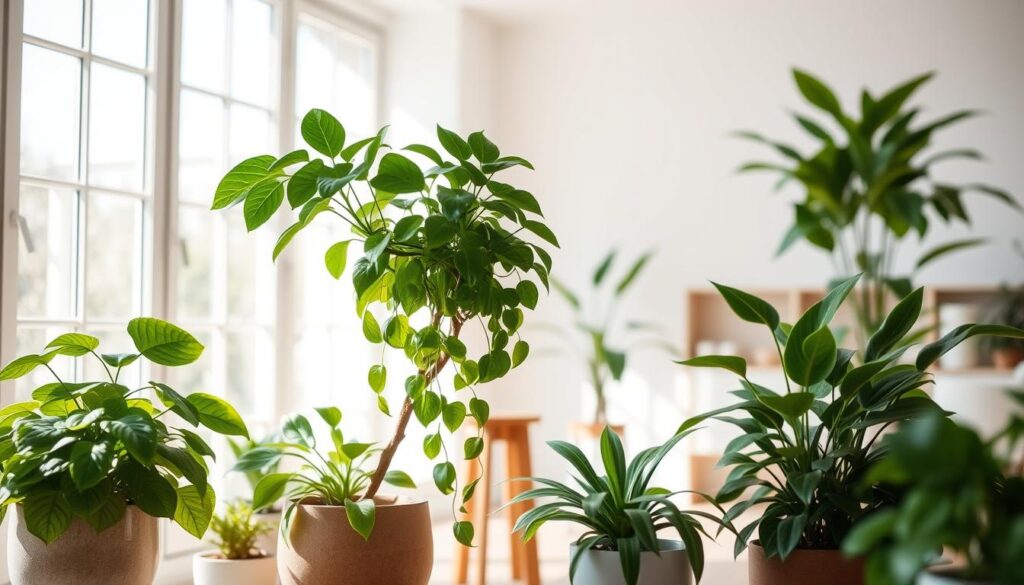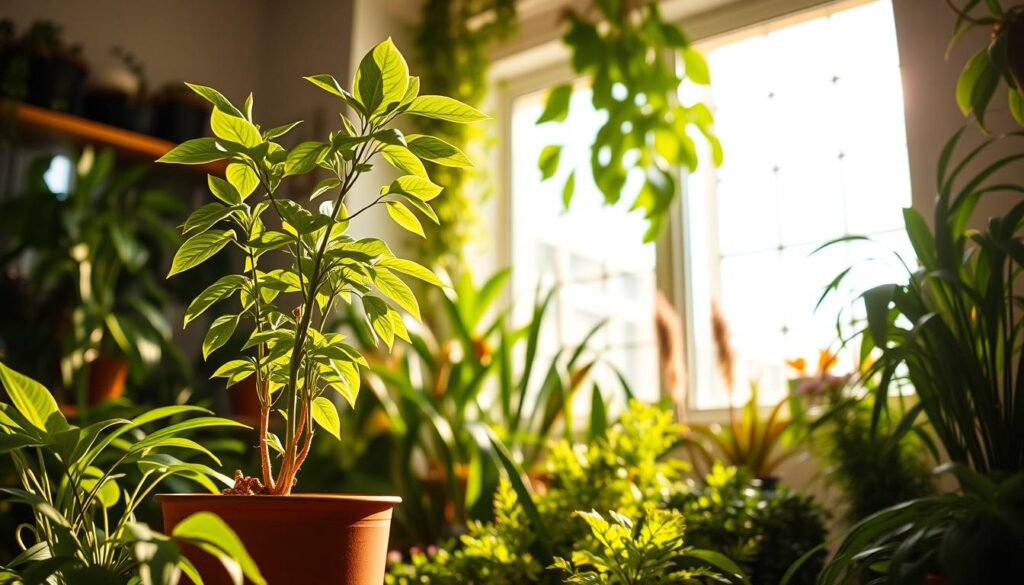Indoor Plant Care Essentials for Healthy Growth

About the Game
Indoor gardening is now more popular, letting people bring the outside in with houseplants. Taking care of these plants well is key to keeping them healthy and long-lasting. Things like the right amount of light, water, and food are important for their growth.
It’s also vital to know what each kind of plant needs. This is especially true for easy-to-care-for plants like snake plants, pothos, and philodendrons. Knowing this helps them grow well.
The Importance of Indoor Plant Care
Indoor plant care is key to a lively and healthy living space. It’s not just about looks; it improves air quality and well-being too. Houseplants clean the air by taking out toxins, creating a cleaner place to live.
Anúncios
Having plants indoors brings many perks, like making you feel better and helping you think clearer. Being around plants, even inside, helps your mind feel good. Studies show that plants inside can lower stress, help you concentrate better, and make you more productive.
To enjoy what houseplants offer, knowing how to take care of them is crucial. They need the right amount of water, light, and good soil to grow well. With a bit of knowledge and effort, your houseplants will flourish, making your home and mind better.
Anúncios

Understanding Plant Light Requirements
Plants have a range of light needs, depending on their type. It’s key to know these needs for healthy growth. They mostly need full sunlight, bright indirect light, or low light. These needs decide how and where to place them in your space.
Types of Light
Different lights affect plants in unique ways:
- Full Sunlight: Such plants need direct sunlight for over six hours a day. They do best near windows facing south or west.
- Bright Indirect Light: These plants need bright light but shouldn’t get direct sun. East-facing windows or places with sheer curtains work well for them.
- Low Light: Plants that like the shade do well in minimal light. They’re good with north or east-facing windows and darker areas.
Artificial lights can help plants when there’s not enough sun. Grow lights offer the right light for plants to stay healthy and grow well.
Watering Techniques for Healthy Plants
Knowing how to water plants right is key to keeping them healthy. Different plants need different amounts of water, depending on where they live. It’s important to check the soil’s moisture to avoid problems like giving plants too much water.
Watering Best Practices
To help your plants grow well, remember these tips:
- Regularly check how moist the soil is by putting your finger into it up to 1-2 inches.
- Only water when the soil’s top feels dry, and think about what each plant needs.
- Succulents need less water than ferns because they are different kinds of plants.
- Use pots that let water flow out to stop water from sitting at the bottom.
- If leaves turn yellow, you might be watering too much, which is a common mistake.
By paying close attention and watering properly, your indoor plants will look healthy and beautiful.
Essential Soil Types for Indoor Plants
Choosing the right soil types is key for healthy indoor plants. It serves as the foundation, providing nutrients and support. Most houseplants do well in an all-purpose potting mix, as it keeps moisture without being too wet.
However, cacti and succulents need special soil with sand or perlite. This mixture allows excess water to drain, preventing root rot. It’s also vital to use fresh, sterile potting mixes to cut down on disease risks. By changing old soil when repotting, you boost the plant’s nutrition and create a healthy root environment.
Humidity Levels and Plant Health
Maintaining optimal indoor humidity is crucial for houseplant health. Many plants, especially tropical ones, need 40% to 60% humidity. Low air moisture can cause wilting leaves and slow growth. This is especially true in winter when heating dries out the air.
Optimizing Humidity
To keep plants healthy, try these humidity-boosting methods:
- Misting leaves regularly to increase moisture around your plants.
- Utilizing pebble trays filled with water, allowing evaporation to enhance humidity.
- Employing humidifiers, especially in dry seasons, to create a suitable environment.
These steps can greatly boost indoor humidity. This makes the perfect environment for plants to grow, leading to vibrant and healthy-looking leaves.
Temperature Needs for Thriving Houseplants
Understanding how warm or cold your indoor plants need to be is key. Most thrive at 60-75°F. This range lets them make food, drink water, and get nutrients without trouble. Keeping the right temperature avoids harm from too much heat or cold.
Temperature Guidelines
Here’s how to keep your indoor plants happy:
- Avoid placing plants near drafts, air conditioning vents, or heaters.
- Monitor your home’s temperature regularly, especially during seasonal changes.
- When relocating plants, gradually acclimate them to their new environment to prevent plant shock.
By following these tips, you’ll maintain the perfect temperature. This supports strong growth all year round.
Fertilizing Tips for Robust Growth
Successful plant fertilization keeps indoor plants healthy and strong. Knowing when to fertilize plants is key, mainly in spring and summer. This is when houseplants grow most and need lots of nutrients.
There are different types of fertilizers for indoor plants. Choosing the right type is crucial for growth. You can pick from:
- Liquid fertilizers: Easy to apply and quickly absorbed.
- Granular fertilizers: Provide a slow release of nutrients over time.
- Organic fertilizers: Often derived from natural sources, promoting overall plant health.
Following label instructions is important to avoid overfertilizing, which can harm your plants. Watching and changing how you fertilize, based on how the plants are doing, helps them grow strong.
Pruning and Cleaning Your Indoor Plants
Caring for indoor plants means regularly pruning and cleaning them. These steps make your plants look better and stay healthier. Pruning makes plants grow more leaves, and cleaning the leaves stops dust from blocking sunlight.
Pruning Techniques
Proper pruning keeps your plants looking good and healthy. Some key methods are:
- Deadheading: Remove old flowers to make way for new ones.
- Trimming: Cut back long growth to help the plant look fuller.
- Thinning: Take out too many branches so air can flow better.
- Shearing: Trim for a tidy, even shape.
It’s important to clean your plant’s leaves regularly. Use a wet cloth to wipe them. This removes dust and lets more light reach the leaves. By doing this, you help your plants grow well and look their best.
Plant Care: Keeping Pests and Diseases at Bay
Keeping your indoor garden healthy means watching out for pests and diseases. Check your plants often. This helps spot trouble early, making it easier to deal with. Knowing when your plants are in trouble can save them from serious harm.
Pest Management
It’s key to have a good plan to protect your plants from unwanted bugs. Here are some steps you can take:
- Inspect plants frequently for pests like aphids, spider mites, and scale.
- Wash leaves gently to remove any pests and debris.
- Use insecticidal soap for more persistent infestations.
- Apply neem oil as a natural insect repellent and for broader pest control.
Acting quickly can stop plant diseases. Issues like root rot and powdery mildew start when problems go unnoticed. By using these pest control tips, you can fight off many common diseases. This helps your indoor garden flourish.
Conclusion
Caring for indoor plants is more than just watering them. It requires attention to light, humidity, temperature, and food. This helps promote healthy growth. By knowing what each plant needs, you can create a perfect environment for them.
Knowing how to care for plants is key. Make sure they get enough light, the right humidity, and the perfect temperature. Spending time on these things can make your indoor garden thrive.
Looking after your plants well can make your home look better and feel happier. Happy gardening starts with making smart choices. This makes the journey of caring for indoor plants both fun and fulfilling.
FAQ
What are the best indoor plants for beginners?
How do I determine the right light exposure for my houseplants?
How often should I water my indoor plants?
What type of soil should I use for houseplants?
How does humidity affect indoor plants?
What temperatures are ideal for indoor plants?
When and how should I fertilize my houseplants?
Why is pruning necessary for indoor plants?
How can I manage pests in my indoor garden?
What are the benefits of indoor plants?
Game Details
No
No